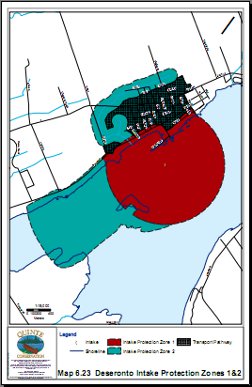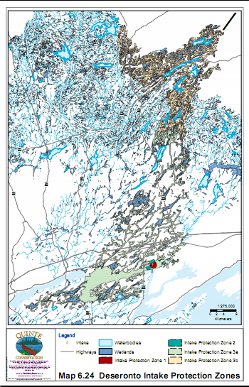deseronto
Ontario's Clean Water Act requires the establishment of regional Source Protection Committees that must develop local science-based protection policies to safeguard water sources in vulnerable areas.
The town of Deseronto is part of the Quinte Source Protection Region, whose Source Protection Committee is actively encouraging public input into the development of a source protection plan. Deseronto is in the Bay of Quinte Watershed (see the Quinte Region Proposed Assessment Report's Map 6.1 Bay of Quinte Catchment Area). The region's plan will include policies and programs intended to protect water sources and will be implemented following approval by the Ontario Ministry of the Environment.
Information below is taken from the Quinte Region Proposed Assessment Report. This Report had not yet been approved by the Ontario Ministry of the Environment when the information below was posted here in March of 2011. As such, information shown on this page may be subject to change. For current information please go to: www.quintesourcewater.ca.
Deseronto's Source of Drinking Water
The town of Deseronto sources its water from the Bay of Quinte.
The water is taken approximately 480 m from the shore, at a depth of 6 m from the surface. A system of low lift pumps transfer water from the bay to a treatment plant. (see the Quinte Region Proposed Assessment Report Map 2.3 for the area serviced by the plant).
The Deseronto waste water treatment plant discharges into the bay less than 1km east of the drinking water intake.
Water in the Bay of Quinte flows from west to east and its major source is the Trent River system. The Bay is an international area of concern and has an established Remedial Action Plan (RAP). Efforts have been underway over the past 16 years to improve water quality. Algal blooms were a persistent concern in the past, but have recently been less of a problem due to efforts to reduce phosphorus inputs.
Intake Protection Zones
Protecting the area around a surface water intake means protecting the surrounding water and, in most cases, the land that surrounds the water. This area of water and land is known as an intake protection zone (IPZ). The size of an IPZ is determined by the time that it takes for a material spilled in or near the water to flow into the water intake pipe. (see more info below below the maps)
Click on the maps below to enlarge


Map 6.23: Deseronto IPZs 1 & 2 Map 6.24: Deseronto IPZs
From the Quinte Region Proposed Assessment Report
In Ontario, Intake Protection Zones are separated into three categories:
- IPZ-1: The area immediately adjacent to the intake. This zone is considered the most vulnerable since any contamination would have little opportunity for being diluted before reaching the intake. It is usually a 1-km radius around the intake with a setback on land of 120 metres from the shoreline.
- IPZ-2: An area upstream where a spill might reach the intake pipe before the plant operator can react (minimum time of 2 hours) (IPZ-2)
- IPZ-3: A larger part of the watershed where contaminants might find their way into the intake pipe; this zone may be impacted by extreme events such as storms, strong winds, or high waves.
Threats to Drinking Water Quality
Activities that contribute to drinking water issues are considered drinking water threats. A number of threats to drinking water quality have been identified in the Quinte Region Proposed Assessment Report.
Significant threats to the IPZ-1 and IPZ-2 include the application of agricultural source material and non-agricultural source material to land.
Table 6-34 on page 6-72 of the Quinte Region Proposed Assessment Report conveys moderate and low chemical threats in the Deseronto region. These include:
- the storage of agricultural source material
- the application, handling and storage of pesticides
- the application of road salt
- the handling and storage of fuel
- the handling and storage of organic solvent
Take Action
Learn how you can support your sources of drinking water, including how to dispose of your household hazardous wastes.
Source and for more information:
Quinte Region Proposed Assessment Report

